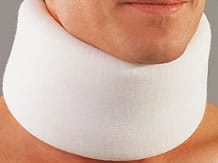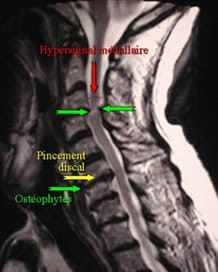The treatment of the manifestations of cervical osteoarthritis, apart from its complications, is essentially medical. It combines non-pharmacological and pharmacological measures.
Non-pharmacological treatments

Orthotic therapy
A cervical collar can be used during painful flare-ups.
The degree of restraint will vary depending on the intensity of pain: simple foam collars, with or without rigid reinforcement or chin support.
Patient education
Learning about preventive measures is part of patient education. This education brings together notions passed on to patients, designed to amend their potentially harmful posture habits. Advice for maintaining the cervical spine should be given to prevent further broad movements of the neck and carrying heavy loads.
Rehabilitation
Rest is necessary during painful flare-ups.
Physiotherapy performed during painful episodes uses different techniques: relaxing massages, physiotherapy via parafango therapy, short-wave therapy and infrared therapy. Between flare-ups, physical therapy combines passive and active rehabilitation with proprioceptive work and mastery of preventive joint care techniques. The exercises are explained to the patient so that they can reproduce them at home regularly.
Spinal manipulation
Publications on spinal manipulation are numerous and contradictory.
According to the recommendations of the Cochrane Database: "Manipulations conducted alone are not indicated; it is in combining them with mobilisation techniques and exercises that enables getting the best results."
They must always be performed by a physician trained in these techniques, in the absence of any contraindications. Serious complications may arise (paresis, vertebral artery dissection, transient hearing loss).
Cervical traction
Cervical traction, performed over several hours in a hospital environment or on a medical table in a doctor's surgery, seem to have an analgesic effect, however, existing clinical studies have been considered insufficient and there are no recommendations for this type of technique in cervical osteoarthritis.
Pharmacological treatments
Analgesics, NSAIDs
Tier 1 analgesics are still used as first-line: paracetamol remains the most widely used product, often for long periods. For significant pain minor opioid derivatives (possibly associated with paracetamol) can be used. Analgesics should be taken in a regular and systematic way.
Non-steroidal anti-inflammatory drugs are used only during the most pronounced painful flare-ups, with great caution in elderly patients. They can be associated with gastroprotection or replaced by a coxib in respecting any contraindications.
Corticosteroids can be used in uncomplicated cervical osteoarthritis in case of contraindications to NSAIDs. Priority should be given to a short treatment, usually administered at a dose of 1mg/kg per os.
Muscle relaxants are useful during acute flare-ups but may promote sleepiness. One must be particularly cautious in prescribing them to active people (driving) and elderly patients (risk of falls). Taking them outside of acute painful flare-ups should be mainly reserved for the evening. Antidepressants can be used in the event of a psychological impact of chronic pain.
Spinal injections
Cervical injections are not indicated in uncomplicated neck pain in cervical osteoarthritis.
However, if there is associated cervicobrachial neuralgia that is resistant to NSAIDs and oral corticosteroids, one may proceed with intrathecal injections of hydrocortisone in the lumbar spine followed by placing the patient in a tilted position (Trendelenburg) carried outduring a short stay in hospital. Foraminal injections are contraindicated.
Surgical treatment
Surgical treatment is reserved for complicated forms: cervical spondylotic myelopathy or cervico-brachial neuralgia by disco-radicular conflict.
Surgical treatment of cervical spondylotic myelopathy is indicated in the event of failure of medical measures, that is to say, in cases of worsening of a neurological deficit or recurrence of a deficit that had previously regressed under medical treatment.
The aim is medullary decompression.
The procedure carried out has a better prognosis if the neurological deficit is recent. It appears that only a small percentage of patients with cervical spondylotic myelopathy are actually operated on.
Complications arising from this surgery are now rare (worsening of the deficit, another radicular deficit, tetraplegia).

Myélopathie cervicarthrosique, IRM séquence T2, coupe sagittale
Bibliography
- Tiffreau V et coll. Traitements physiques et cervicalgies communes. Revue du rhumatisme 2004 ; 71(8) : 715-720.
- Gross M. Kinésithérapie des cervicalgies. Encyclopédie medicochirurgicale Kinésithérapie-Médecine physique-Réadaptation [26-294-C-10].












